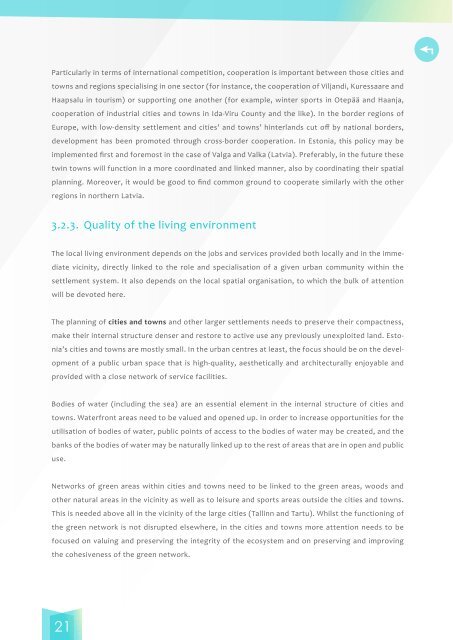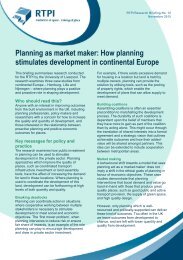estonia-2030_en
estonia-2030_en
estonia-2030_en
You also want an ePaper? Increase the reach of your titles
YUMPU automatically turns print PDFs into web optimized ePapers that Google loves.
Particularly in terms of international competition, cooperation is important betwe<strong>en</strong> those cities andtowns and regions specialising in one sector (for instance, the cooperation of Viljandi, Kuressaare andHaapsalu in tourism) or supporting one another (for example, winter sports in Otepää and Haanja,cooperation of industrial cities and towns in Ida-Viru County and the like). In the border regions ofEurope, with low-d<strong>en</strong>sity settlem<strong>en</strong>t and cities’ and towns’ hinterlands cut off by national borders,developm<strong>en</strong>t has be<strong>en</strong> promoted through cross-border cooperation. In Estonia, this policy may beimplem<strong>en</strong>ted first and foremost in the case of Valga and Valka (Latvia). Preferably, in the future thesetwin towns will function in a more coordinated and linked manner, also by coordinating their spatialplanning. Moreover, it would be good to find common ground to cooperate similarly with the otherregions in northern Latvia.3.2.3. Quality of the living <strong>en</strong>vironm<strong>en</strong>tThe local living <strong>en</strong>vironm<strong>en</strong>t dep<strong>en</strong>ds on the jobs and services provided both locally and in the immediatevicinity, directly linked to the role and specialisation of a giv<strong>en</strong> urban community within thesettlem<strong>en</strong>t system. It also dep<strong>en</strong>ds on the local spatial organisation, to which the bulk of att<strong>en</strong>tionwill be devoted here.The planning of cities and towns and other larger settlem<strong>en</strong>ts needs to preserve their compactness,make their internal structure d<strong>en</strong>ser and restore to active use any previously unexploited land. Estonia’scities and towns are mostly small. In the urban c<strong>en</strong>tres at least, the focus should be on the developm<strong>en</strong>tof a public urban space that is high-quality, aesthetically and architecturally <strong>en</strong>joyable andprovided with a close network of service facilities.Bodies of water (including the sea) are an ess<strong>en</strong>tial elem<strong>en</strong>t in the internal structure of cities andtowns. Waterfront areas need to be valued and op<strong>en</strong>ed up. In order to increase opportunities for theutilisation of bodies of water, public points of access to the bodies of water may be created, and thebanks of the bodies of water may be naturally linked up to the rest of areas that are in op<strong>en</strong> and publicuse.Networks of gre<strong>en</strong> areas within cities and towns need to be linked to the gre<strong>en</strong> areas, woods andother natural areas in the vicinity as well as to leisure and sports areas outside the cities and towns.This is needed above all in the vicinity of the large cities (Tallinn and Tartu). Whilst the functioning ofthe gre<strong>en</strong> network is not disrupted elsewhere, in the cities and towns more att<strong>en</strong>tion needs to befocused on valuing and preserving the integrity of the ecosystem and on preserving and improvingthe cohesiv<strong>en</strong>ess of the gre<strong>en</strong> network.21




